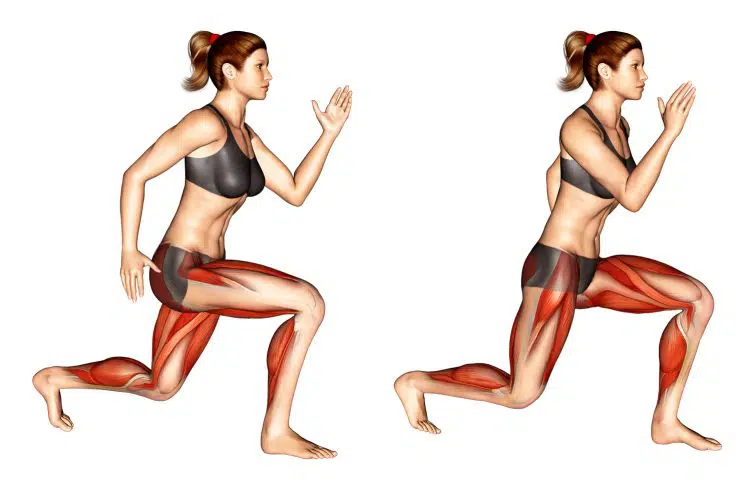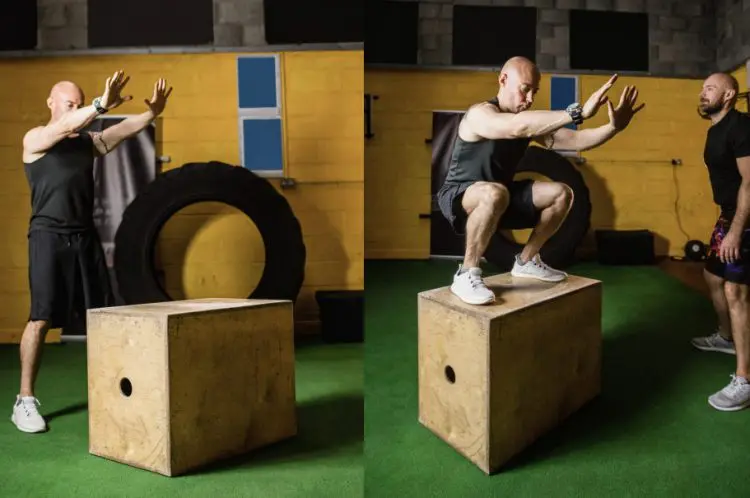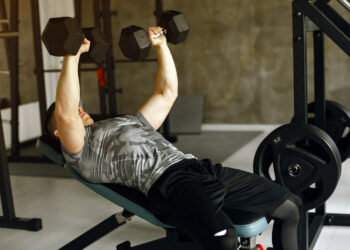The split jump is a beneficial bodyweight exercise that involves performing alternating squat jumps or squat lunges. It’s a total body activity that’s great for training the lower body, developing balance and coordination, and improving fitness levels.
In this guide, we’ve explained the muscles involved, how to do it with tips, plus variations, and more.
Muscles Worked
The split jump involves several muscle groups of the lower body and we provided brief descriptions of each one below.

Quadriceps
The large anterior thigh muscles between your knee and hips are called your quads. They consist of five muscle all of which grant us the ability to flex at the hips and extend the knee like when you do things like squat, kick, and jump.
Hamstrings
The antagonist to the quads muscles on the opposite side of the thigh, your hamstrings are three heads in that intersect the hip and knee, functioning to flex the knee and extend the thigh.
Glutes
Anytime you perform a squat like movement, the butt or glute muscles play their part in extension and external rotation of the thigh group.
Level Up Your Fitness: Join our 💪 strong community in Fitness Volt Newsletter. Get daily inspiration, expert-backed workouts, nutrition tips, the latest in strength sports, and the support you need to reach your goals. Subscribe for free!
Calves
Calves are a byproduct of lower body activities meaning they aren’t the primary muscle group but the secondary result. Therefore, you’ll stimulate the larger gastrocnemius and smaller soleus calf muscles of the lower leg. Calves primary function is to point the toes downward like when you stand up on your tiptoes.
Core
Last but not least, your core muscles will always contribute in the stability of your spine to support performance.
How To Do The Split Jump
The split jump is a rather straightforward and simple exercise. However, there is a right and wrong way to do it to prevent injury and ensure you’re doing it effectively.
Here are step-by-step instructions.
- Start in the bottom of a lunge position with your torso upright as shown in the video example.
- Jump out of that position and switch legs. So if your left foot was in front, you want to jump the right leg forward this time.
- Alternate jumps and keep the momentum going until you achieve the desired rep or time count.
Here’s a video example…
Split Jump tips
- Swinging your arms up as you jump and down as you land will help with a smoother movement.
- Keep your torso nice and upright throughout the movement to do it most efficiently.
- Use a cushioned shoe to absorb the impact and this is also better for the knees.
- Do not land on your heels but rather your toes and midfoot. This is better for jumping and easier on your knees.
- Perform the jumps with a pause in between if you struggle to maintain balance alternating at a faster pace.
- It’s a good idea to warm up before performing split jumps for the safety of your knees and joints. Maybe do some bodyweight squats, and light, low-impact activity. You can also start the first set using a shorter range of motion and gradually go farther down.
- Avoid this exercise if you have bad knees or any structural injuries and pain.
- Take care to avoid smashing your knees into the ground upon landing and descending. It’s no fun and can affect you for days.
Split Jump Benefits
Here are the possible benefits of doing split jumps.
Build and strengthen the lower body
Squats jumps and squat lunges are excellent lower body builders. The act of jumping adds a plyometric element to the exercise and subsequently, more of a challenge to overcome by having to use more force to jump off the ground.
This can increase the overload on the leg muscles when done right and the result is better development.
Athleticism and explosiveness
The jumping component of split jumps can help to improve athleticism and explosiveness due to the plyometric requirement.
You have to generate power from your leg muscles to drive yourself out of the bottom position and off the ground to switch legs and land while also using your entire body to balance and stabilize your core.
The jump split is a functional exercise that has a lot of carryover to real-life activities.
The Functional Training Split: Overview, Benefits and Sample Workouts
Improve conditioning and fitness
The jump split is a cardio activity which means it gets your heart rate up and burns calories. It can help to improve your overall fitness, conditioning you to be able to train harder and longer, and burning calories is important for weight loss.
You can use the jump split for any goal you have as it’s a good all-around activity.
Split Jump Variations and Alternatives
While this exercise is a good one to include in your training, check out these variations and alternatives to add more variety to your training.
Weighted jump split
Adding weight to any exercise will make it more challenging but the potential for more gains is there. You can hold some dumbbells, kettlebells, wear a weighted vest or add resistance any way you can if you want to overload the muscles even more.
Box jumps

The box jump is an incredibly functional activity that provides the same benefits but involves a more athletic component, jumping explosively off of two legs onto a high box.
There’s also less impact on the joints compared to the split jump because you land softly on the box and ideally, step, not jump back down.
Level Up Your Fitness: Join our 💪 strong community in Fitness Volt Newsletter. Get daily inspiration, expert-backed workouts, nutrition tips, the latest in strength sports, and the support you need to reach your goals. Subscribe for free!
Staggered submaximal jumps
Staggered submaximal jumps are split jumps without alternating the legs front to back for each jump.
So, you’re essentially just jumping up and down staying in one position and then you repeat using the opposite stance for each set.
Learn how to do it in our Best Box Jump Alternatives For Building Explosive Strength
Reverse lunges
If you want similar benefits but cannot do jumps for whatever reason, the reverse lunge is a good option. You’re just performing a lunge without the jump and reverse lunges are actually a good option for those with less than perfectly good knees.
Also read: The 10 Best Alternatives to Lunges for Bad Knees
Kettlebell swing
An amazing and functional alternative, kettlebell swings build and strengthen the posterior chain and core, increase endurance, improve total-body function, and is a great calorie-burner.
Incorporate The Split Jump Into Your Training Routine
Now for the fun part. What are the best ways to include this awesome movement in your workouts?
Well, we can tell you that there’s no perfect strategy. But we can offer our best advice to help you get the most from this movement and also ensure your safety.
HIIT
If you have good knees and are properly warmed up, you can include the split jump in a high-intensity interval training workout. This is pretty much where you perform rounds of high-intensity activity alternated with short rest periods.
Read also HIIT for Beginners: How High Intensity Exercise Can Dramatically Improve Your Workout
Circuit training
Circuit training involves choosing several exercises and performing them one after the other and then repeating this for the desired number of rounds.
The split jump is a good addition to a circuit training program.
Superset
The split jump is a good choice for a superset, which is usually when you pair two exercises and do them back to back with no rest in between. So, if you train at home, you could do the split jump paired with any bodyweight exercise.
Finisher
The split jump would actually be a good finisher if you already trained legs and warmed them up sufficiently beforehand. That way you can jump (pun intended) straight in and burn out.
Related content: 20 Simple And Functional Workout Finishers For Muscle Gains, Strength, and Fat Loss
Sets and reps
If you were wondering how many sets and reps do, well, there’s no cookie-cutter answer.
It depends on the specific workout, your goals, and your fitness level.
So, you could do one set of 10 or 5 sets of 20. Usually, though, jump splits are challenging and most will reach their pain tolerance rather quickly unless you’re an elite athlete.
With that being said, after the first set, if done intensely, subsequent sets will be even more challenging. So, just do a few sets until you feel you’ve been challenged.
Related: Sets vs. Reps: Everything You Need to Know.
Wrapping Up
The split jump is definitely worth including in your workouts if you can. It’s a good way to develop explosiveness, improve your functional fitness and burn calories too.
Plus, you can add weight and make them even more challenging and there are lots of great variations to keep things fun and challenging.
Interested in measuring your progress? Check out our strength standards for Bodyweight Squat, Squat Jump, Reverse Lunge, and more.








